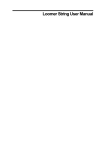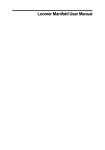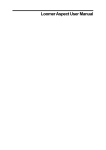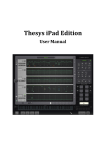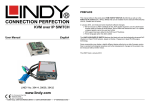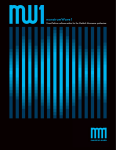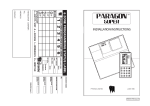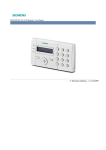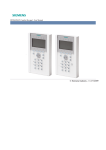Download Loomer Shift User Manual
Transcript
Loomer Shift User Manual
End User Licence Agreement
Software Licence Agreement for Shift
Credits
Development Credits
Requirements
Mac OS X requirements
Windows requirements
Linux requirements
Shift Overview
What is Shift?
Plug-in vs Standalone
Shift formats
Supported channel configurations
Installation and Registration
Mac OS X installation
Windows installation
Linux installation
Product registration
For Shift 1 Users
Audio and MIDI Configuration Setup Audio and MIDI
Preset Management
Parameters and Presets
Navigation Controls
Opening Presets
Preset Hot-Swap
Preset Meta Data
Searching for Presets
Categories
Saving Presets
XML / FXP / FXB support
Copying & Moving Presets
MIDI Program Change Lists
Create a new Preset
Compare a changed Preset to the original Preset
Restoring Deleted Factory Presets
User folder management
Partial Presets
Creating a Partset
Loading a Partset
Partset Hot-Swap
Restoring Deleted Factory Partsets
4
4
6
6
7
7
7
7
8
8
8
9
9
10
10
10
11
11
12
13
13
15
15
15
15
16
16
16
17
17
17
17
17
18
18
18
18
18
19
19
19
19
2
MIDI Controller Mapping
MIDI controllers
Display current MIDI controller mappings
Assign MIDI controllers to controls
Remove MIDI controller mappings from controls
Using Shift
Audio Signal Flow
Interface
Volume
Delay Voices
Delay Voice Modulation
XY Pad
Time Snap
Global
LFO
Grain
Dry Volume
Tracking
CPU Usage
Latency
Control types
Status Display
MIDI input monitor
Tempo control
Contact Details
Loomer Online
Email
20
20
20
20
21
22
22
23
23
24
25
25
26
26
26
26
27
28
29
29
30
31
31
31
32
32
32
3
End User Licence Agreement
Software Licence Agreement for Shift
1. GRANT OF LICENCE: Subject to the terms below, Loomer hereby grants you a nonexclusive, non-transferable licence to install and to use Shift ('Software'). Under this
licence, you may: (i) install and use the Software for your personal, internal use (ii) copy
the Software for back-up or archival purposes; (iii) use an unregistered or evaluation
version of the Software for evaluation purposes only. (iv) You may not distribute the
software to others without first obtaining the required licences, where applicable. Whether
you are licensing the Software as an individual or on behalf of an entity, you may not: (i)
reverse engineer, decompile, or disassemble the Software or attempt to discover the
source code; (ii) modify, or create derivative works based upon, the Software in whole or
in part without the express written consent of Loomer; (iii) distribute copies of the
Software; (iv) remove any proprietary notices or labels on the Software; (v) resell, lease,
rent, transfer, sublicense, or otherwise transfer rights to the Software; By installing,
copying, or using the Software, you (either on behalf of yourself as an individual or on
behalf of an entity as its authorized representative) agree to all the terms of this End User
Licence Agreement ('Agreement') regarding your use of the software. If you do not agree
with all the terms of this Agreement, you may not use the Software.
2. Shift: You acknowledge that no title to the intellectual property in the Software is
transferred to you. Title, ownership, rights, and intellectual property rights in and to the
Software shall remain that of Loomer . The Software is protected by copyright laws and
international treaty provisions.
3. DISCLAIMER OF WARRANTY: You agree that Loomer has made no express warranties,
oral or written, to you regarding the product and that the products are being provided to
you 'as is' without warranty of any kind. Loomer disclaims any and all other warranties,
whether expressed, implied, or statutory. Loomer shall not be liable for indirect, incident,
special, cover, reliance, or consequential damages resulting from the user of this product.
4. LIMITATION OF LIABILITY: You use this program solely at your own risk. In no event
shall Loomer be liable to you for any damage, including but not limited to any loss, or
other incidental, indirect or consequential damages of any kind arising out of the use of
the software, even if Loomer has been advised of the possibility of such damages. In no
event will Loomer be liable for any claim, whether in contract, tort, or any other theory of
liability, exceed the cost of the software. This limitation shall apply to claims of personal
injury to the extent permitted by law.
5. TERMINATION: This Agreement shall terminate automatically if you fail to comply with
the limitations described in this Agreement. No notice shall be required to effectuate such
termination. Upon termination, you must remove and destroy all copies of the Software.
4
6. MISCELLANEOUS: In the event of invalidity of any provision of this Agreement, the
parties agree that such invalidity shall not affect the validity of the remaining portions of
this Agreement. You agree that this is the entire agreement between you and Loomer,
which supersedes any prior agreement, whether written or oral, and all other
communications between Loomer and you relating to the subject matter of this
Agreement.
Reservation of rights.
'VST' is a trademark of Steinberg Soft - und Hardware GmbH. All other trademarks are
the property of their respective owners.
All rights not expressly granted in this Agreement are reserved by Loomer.
5
Credits
Development Credits
Shift © 2009 - 2015 Loomer
Developed by
Interface by Loomer
Kevin Barry - http://www.inquer.co.uk
Tested by
Clifton Cameron
kuniklo
Scott Simons (rexlapin)
taoyoyo
VST PlugIn Technology by Steinberg Media Technologies GmbH. This software is based
in part on libpng, zlib, and JUCE.
6
Requirements
Mac OS X requirements
• Requires Mac OS X v. 10.5 or later
• x86 based processor 1.0Ghz, or above, with SSE
• 512 MB RAM
Windows requirements
• Windows XP or Windows Vista, or above
• Intel x86 based processor 1.0Ghz, or above, with SSE
• 512 MB RAM
Linux requirements
• Intel x86 32-bit or or 64-bit based processor 1.0Ghz, or above, with SSE
• 512 MB RAM
The following shared object libraries are required:
• libfreetype
• libasound
• libXinerama
7
Shift Overview
What is Shift?
Shift is a real-time diatonic granular pitch shifting and delay effect. Shift has five
independent true stereo delay voices with discrete tune, time, feedback, pan, filter, and
volume controls. An XY Pad control gives at-a-glance visual feedback as to the state of
the delay voices, and allows multiple parameters to be tweaked and played live.
Each voice can be transposed by as much as an octave up or down using both coarse
semitone and finely grained cent amounts. In Echo Shift mode, echoes are fed back into
the pitch shifter, continually transposing each individual repeat. In Diatonic mode, the
accurate and responsive pitch tracker follows any monophonic audio source and tunes
the pitch of the delay voice harmonies to remain in key and in scale.
Shift's echoes can either be synced to the host tempo (expressing delay times as musical
subdivisions of a beat, with each echo exactly in time with the host) or in free-time mode
(allowing fine tuning of the delay times, up to 2 seconds.) With four sync-able low
frequency oscillator (LFO) components, each delay voice parameter can be independently
modulated, generating a huge range of sounds, from subtle detuning to extreme audio
mangling.
True independent stereo processing means that left and right channel separation is
preserved. Shift is also capable or running in mono, or even mono to stereo.
Shift comes with over 100 built-in factory presets, each annotated and tagged so you can
quickly locate them. Presets can even be ‘hot-swap’ previewed without losing your
current sound. And with Partial Preset support, you can effortlessly share settings for the
Delay Voices, Grain engine, and Diatonic Tracker between presets.
With optimized audio algorithms that won't overload your processor, rock-solid
stability, and easy integration with any MIDI hardware controller, Shift is ideal for live work.
With a simple and intuitive interface, flexible preset management, and total parameter
automation, Shift fits right into your studio environment.
Plug-in vs Standalone
Depending upon your individual studio setup, Shift can either be used as a plug-in
component of a host application, or as a standalone application requiring no other
dependencies. Generally, by using the host application's routing flexibility, running as a
plug-in allows easier integration with existing plug-in effects and instruments. If this
integration is not required, the standalone version, without the extra layer of complexity
added by the host consuming resources, performs slightly better.
Presets and MIDI Mapping assignments are identical in both standalone and plug-in
versions. This means any sounds created in one format can be opened in the other.
8
Shift formats
For the Mac, the following formats are provided:
• Standalone Application
• Audio Unit (AU) Plug-In (32-bit and 64-bit)
• VST Plug-in
• RTAS Plug-In
• AAX Plug-in (64-bit)
These formats are available for Windows PC:
• Standalone Application
• VST Plug-in (32-bit and 64-bit)
• RTAS Plug-in
• AAX Plug-in (64-bit)
These formats are available natively for Linux:
• Standalone Application (32-bit and 64-bit)
• VST Plug-in (32-bit and 64-bit)
Supported channel configurations
For maximum flexibility, Shift can be used in several possible input and output channel
configurations. Shift is a true stereo effect: left and right channel separation is preserved.
The following configurations are possible:
• mono to mono (1 input, 1 output)
• mono to stereo (1 input, 2 outputs)
• stereo to stereo (2 inputs, 2 outputs)
Note that some host applications may not support one or more of these configurations;
consult your host's documentation for further details.
9
Installation and Registration
Mac OS X installation
1. Start the installation process by double-clicking the Shift installer application.
2. Read the introduction screen dialog text. Press Continue when you are ready to
proceed.
3. Read the Licence Agreement. Click Continue, then Agree to confirm you have read
and agree to the licence terms.
4. Select a destination volume into which to install Shift, and then click Continue.
5. From the list of installable components, uncheck any formats that you do not wish to
install. Click Continue to proceed.
6. To complete the installation, press Install.
The components are, by default, installed into the following directories:
• VST plug-in into /Library/Audio/Plug-Ins/VST
• Audio Unit plug-in into /Library/Audio/Plug-Ins/Components
• RTAS plug-in into /Library/Application Support/Digidesign/Plug-Ins
• AAX plug-in into /Library/Application Support/Avid/Audio/Plug-Ins
• Standalone application into /Applications
• Documentation into /Library/Documentation/Loomer
Windows installation
1. Start the installation process by double-clicking the Shift installer application,
Setup.exe.
2. Read the welcome screen dialog text. Press Next when you are ready to continue.
3. Read the Licence Agreement. Click I Agree to confirm that you have read and agree
to it.
4. From the list of installable components, uncheck any formats that you do not wish to
install. Click Next to continue.
5. If you have chosen to include the VST plug-in format, select the directory into which it
will install. Click Next to continue.
6. Select a directory into which the common files will install. The user documentation and
the Standalone application (if selected in the the list of components), will be placed in
this location. To complete the installation, press Install.
Unless any other directories are selected during the installation, the components are
installed into the following directories:
• VST plug-in into the VST plug-ins folder, which is, unless configured otherwise,
C:\Program Files\Steinberg\VSTPlugins\
• RTAS plug-in into C:\Program Files\Common Files\Digidesign\DAE\Plug-Ins\
• AAX plug-in into C:\Program Files\Common Files\Avid\Audio\Plug-Ins\
• Standalone application, documentation and default Bank into C:\Program Files\Loomer
\Shift2. On a 64-bit Windows platform, the Standalone application will install into the
Program Files (x86) folder.
10
Linux installation
Shift for Linux is distributed as a standard Linux tarball. To install, extract the package
using any unarchiving utility; the following command-line invocation will suffice:
tar xzvf Shift2.tar.gz
If you have a Linux VST host and have configured your VST Path, the VST plug-in can be
moved into the required directory with the following commands:
cd Shift2
mv Shift2VST.so $VST_PATH
Without the VST Path configured, you will need to ensure that your host uses the Shift
directory when searching for VSTs; consult your host's documentation for information on
how to do this.
Shift requires the following shared object libraries to be installed:
• libfreetype
• libasound
• libXinerama
Without these libraries installed, the application will not launch. Install the libraries using
your distribution's particular package management system, such as apt-get; consult your
Linux distribution documentation for more information.
Product registration
Having installed Shift, it will run in evaluation mode with the following limitations:
• User created Presets can be saved, but not loaded.
• Audio output will stop after 30 minutes of continuous use. The only way to continue
using Shift is to restart the application.
• Output will be periodically interrupted, approximately every 30 seconds, by a short
moment of silence.
These limitations can be removed by purchasing a licence and registering your licence
information into the product. Note that registering Shift on a particular machine will
remove the evaluation limitations for all Shift plug-in formats installed on this machine;
you don't need to individually register all plug-in formats. Licence information will be in
the form of a user name and licence key.
11
To purchase a Shift licence:
1. Launch Shift. This can be either the standalone application, or as a plug-in.
2. From the Options menu, choose Purchase Shift Licence. This will launch the shop
website, from where a Shift Licence can be purchased by clicking Add To Cart,
followed by Checkout. Follow the on-screen prompts to enter your payment details
and confirm your purchase.
3. Once you have purchased Shift, you will receive your licence key information via
email. It is important to keep this information safe because you will require the licence
key if you ever need to reinstall and re-register Shift.
To register your copy of Shift:
1. Choose Enter Shift Licence from the Options menu.
2. Enter your name in the Name field. This must match exactly the name that was used
to purchase your Shift licence, including capitalization of letters.
3. Enter your licence key in the Licence Key field. This must match exactly the licence
that you received when you purchased Shift, including any hyphens. We recommend
using Copy and Paste to ensure that the Licence Key is entered exactly as specified in
your registration email.
4. Press OK to confirm that your name and corresponding licence key have been
entered. You will be informed that the application must be restarted in order for
registration changes to take effect. If you are currently running the standalone
application, close and relaunch it. If Shift is currently running as a plug-in, remove it
from the host and add a new instance of it.
5. Shift should now be registered. If the label on the bottom of the interface still reads
Unregistered Evaluation, you must have entered the licence information incorrectly. Go
back to step 1, paying careful attention that the name and licence key entered match
exactly the licence information in the registration email.
If you are having problems registering your installation of Shift, please consult the detailed
step-by-step instructions at http://www.loomer.co.uk/support.htm .
For Shift 1 Users
Shift 2 will install alongside earlier versions of Shift. Both versions can be installed and
used together, even in the same project.
Whilst Shift 2 is a free upgrade for registered owners of Shift 1, it requires its own licence
key. If you have a Shift 1 licence and wish to claim your licence for Shift 2, please fill in
the form at http://www.loomer.co.uk/request_licence.htm .
Shift 2 will open presets created for Shift 1, but due to the improvements in Shift 2’s
synthesis engine, they are not guaranteed to sound absolutely identical. In most cases
the changes will be minor, and for the better. Any projects you have previously created
using Shift 1 will not be changed, even when Shift 2 is installed.
12
Audio and MIDI Configuration
Setup Audio and MIDI
When running Shift as a Standalone application, you will need to setup your audio and
MIDI interfaces. Note that when running as a plug-in, audio and MIDI routing is provided
by the hosting application; consult the host's documentation for details. To open the
Audio & MIDI Configuration dialog, select Audio & MIDI Configuration under the
Options menu. The following dialog will be displayed:
Audio Device
Sample Rate
Audio Buffer Size
MIDI Inputs
From this dialog, the following details of your Audio and MIDI setup can be configured:
• Audio Device. Select the Audio Device you want to use from the list of available
devices. Certain devices tend to perform better than others, so if multiple devices are
available, you should favour: on Mac, using Core Audio; on Windows, using ASIO; on
Linux, using JACK.
• Sample Rate. The Sample Rate dictates the overall quality of the audio output. Using a
lower Sample Rate will reduce the presence of high-frequency components. Higher
Sample Rates should therefore be preferred. However, be aware that the CPU Usage is
directly proportional to the Sample Rate. A good compromise between quality and CPU
Usage is 44100Hz, which is the Sample Rate of CD audio. Select the Sample Rate you
require from the available list.
13
• Audio Buffer Size. The Audio Buffer Size governs latency; a smaller buffer means that
Shift will respond more quickly to MIDI messages and Parameter changes. However, a
smaller Audio Buffer Size will require more CPU Usage. Select the required Audio Buffer
Size from the available list. Using too small of an Audio Buffer can overload your
computer to the extent that audible clicks are heard. In this case, increase the Audio
Buffer Size until clicks are no longer present.
• MIDI Inputs. Check any MIDI Input devices that you want to use with Shift.
14
Preset Management
Parameters and Presets
You can modify the audio output that Shift produces by setting the value of Parameters.
Each Parameter, such as ** Delay Time, Feedback, or Highpass, will affect a specific
element of the sound. The state of all Parameters are collectively called a Preset. Presets
are given a suitable name, displayed in the Menu Bar, to describe the sound they
produce.
Preset Name
Previous Preset
Next Preset
Navigation Controls
If you wish to browse quickly through the Presets, you can do so using the the Previous
and Next controls. These controls are context sensitive, only displaying Presets that are
relevant to you. For example, if you search for “analogue, bass”, only Presets that match
this will be shown in the preset browser. The mouse-wheel can also be used to quickly
browse through presets.
Opening Presets
To select a preset from within your preset library, click on the Preset Name in the menu
bar to open the Preset Browser.
15
Presets can be divided into two groups; Factory, and User. Factory Presets are a
collection of example Presets built into Shift. Factory presets can’t be overwritten,
although you can, of course, edit and save your own presets derived from Factory
Presets.
User Presets are stored as individual files on your computer’s hard drive. User Presets are
found in the following location:
Mac OS X: ~/Library/Application Support/Loomer/Shift/Presets/
Linux: $XDG_DATA_HOME/Loomer/Sequent/Presets, or ~/.local/share/Loomer/Sequent/
Presets
Windows: My Documents/Loomer/Shift/Presets/ or Documents/Loomer/Shift/Presets/
Only registered users can open User Presets. Unregistered versions of Shift are limited to
the Factory Presets. Unregistered versions of Shift can, however, still save Presets. Any
Presets created in the unregistered evaluation of Shift can be opened by purchasing a
licence for Shift.
Preset Hot-Swap
Selecting a Preset in the browser will automatically load the preset: this functionality is
called Preset Hot-Swap. Preset Hot-Swap allows you to preview Presets in the context of
the current project. If you decide to use the selected Preset, close the browser by
pressing return or by clicking OK. To return to your original Preset, close the browser by
pressing escape or by clicking Cancel.
Preset Meta Data
Presets can have meta data attached to them. Meta data doesn’t influence the sound of
the Preset, but is used in categorizing, searching, or annotating them. The following meta
data is available:
Author: The name of the Preset creator.
Notes: Any additional notes about the Preset, such as influences, playing tips,
description, etc.
Tags: Tags are short words that describe the Preset. Examples are: “bass”, “distorted”,
“monophonic”, “trance”, “quiet”, etc. Tags are used to help quickly search for a specific
sound.
Searching for Presets
Type keywords into the search field to locate all Presets that match this description. The
search will match the keywords in the Preset Name, Author, and Tags fields, and parent
folder name.
16
Categories
Categories allow you to quickly access a subset of your Presets. Categories are listed
under the Categories node in the Preset Browser. A Category is simply a shortcut to
searching for the Category name; a Category called “Bass” will list all Presets that match
the search criteria “Bass”. You are not limited to create Categories based on the type of
sound: you can, for example, create Categories for Preset Authors, or indeed for any
other search term. Provided you tag your own Presets, they will automatically be added
to the correct Category (or Categories: Presets can belong to multiple Categories; a
Preset could be both a “Bass” and “Lead” sound, for example.)
Saving Presets
Click Save to save the current Preset. Choose the location in which to save the Preset in
the Folders window. Press OK to actually save the Preset.
XML / FXP / FXB support
Presets in the User Presets folder need to be in either native .xml format, or VST .fxp
or .fxb format. Standalone, Audio Unit and RTAS versions can also open .fxp or .fxb files
within the browser. Please ensure any files in the User Presets folder have the correct file
extension.
Copying & Moving Presets
Presets can be moved or copied to another folder by dragging and dropping a Preset
onto the destination folder. By default, Presets will be moved. You can instead copy the
Preset by holding shift whilst dragging. Note that Presets inside Banks (either .xml or .fxb
Banks), can only be copied, not moved. Multiple Presets can be moved or copied at once
by selecting more than one Preset.
Default Preset
The Default Preset is automatically opened when a new instance of Shift is created. To
specify the Default Preset, right-click on a Preset and choose Set as Default.
MIDI Program Change Lists
You can change Presets by using MIDI Program Change commands. This requires a MIDI
keyboard or a control surface with the ability to send MIDI Program Change commands;
consult your controller’s documentation for details. If using Shift as a plug-in, this
functionality is dependent upon the host correctly forwarding MIDI messages to the plugin; check the documentation provided with your host for details.
To select which Presets are loaded in response to MIDI Program Change commands, you
will need to create a MIDI Program Change List. Select Edit MIDI Program Change
List... from under the MIDI menu to display the MIDI Program Change List editor.
17
To add Presets to the MIDI Program Change List, either double-click on a Preset, or
select a Preset and click the >> button. Use the View button to toggle between viewing
the MIDI Program Change List and information on the Selected Preset.
Any Presets in the MIDI Program Change Lists are automatically loaded and cached in
memory. This means that Preset changes can be instant. There may be a slight pause
after editing the MIDI Program Change List whilst the Presets within it are loaded. When a
Preset is saved, any entries in the MIDI Program Change List are saved alongside it. Note
that setting a Preset with a MIDI Program Change List as the Default Preset will cause all
Presets within the list to be loaded when a new instance of Shift is created.
Create a new Preset
Select New to create a new Preset. This Preset will be in the default initialized state.
Compare a changed Preset to the original Preset
Often you’ll want to compare a Preset that you have amended to see if it is is actually an
improvement on the original. Pressing the A | B button temporarily reverts a changed
Preset back to its original state. Pressing the A | B button a second time returns to the
changed Preset. This method allows you to easily contrast the Preset changes you have
made to the original Preset.
Restoring Deleted Factory Presets
To reinstate any deleted Factory Presets, right-click on the Factory branch and choose
Resore Factory Presets.
User folder management
Folder management is performed by right-clicking on a User folder, and selecting an
option from the pop-up menu. From here, you can create a New Folder, Rename Folder,
or Delete Folder. On Windows or Mac OS X, you can also quickly locate this folder in
Finder or Explorer by choosing Show In Finder / Explorer.
Partial Presets
As well as full Presets containing the entire state of Shift, you can also create Partial
Presets (known as Partsets). Partsets contain only the settings for a specified
component. Shift support Partsets for the following components: Delay Voice, Grain
settings, and Diatonic Tracking sensitivity options.
18
User Partsets are stored as individual files on your computer’s hard drive. They are found
in the following location:
Mac OS X: ~/Library/Application Support/Loomer/Shift2/Partsets/
Linux: $XDG_DATA_HOME/Loomer/Shift2/Presets, or ~/.local/share/Loomer/Shift2/
Presets
Windows: My Documents/Loomer/Shift2/Partsets/ or Documents/Loomer/Shift2/
Partsets/
Open Partset
Save Partset
Creating a Partset
To save the current settings for a component into a Partset template, click on the save
icon next to the component. Give the Partset an identifying name, and click OK to save it.
Loading a Partset
To load the current settings for a component from a Partset template, click on the open
icon next to the component, and select the required Partset from the browser list.
Partset Hot-Swap
Selecting a Partset in the browser will automatically load it: this functionality is called
Partset Hot-Swap. Partset Hot-Swap allows you to preview Partset in the context of the
current project. If you decide to use the selected Partset, close the browser by pressing
return or by clicking OK. To return to your original Partset, close the browser by pressing
escape or by clicking Cancel.
Restoring Deleted Factory Partsets
To reinstate any deleted Factory Partsets, right-click on the Root branch node in the
component’s Partset browser, and choose Restore Factory Partsets.
19
MIDI Controller Mapping
MIDI controllers
Instead of configuring a Program using a mouse, you can change any Parameter values
using a MIDI keyboard or a control surface. This is done by mapping each Parameter to a
MIDI Continuous Controller (CC). A Parameter can only be mapped to a single MIDI
controller; the same MIDI control can, however, be mapped to several different
Parameters.
MIDI Controller mappings are global; once defined, the same mapping assignments will
be used by all Shift Programs. This means that you only need define mappings once for
your particular controller.
Display current MIDI controller mappings
To view the current MIDI controller mappings:
1. Enter MIDI Learn Mode by choosing Start MIDI Learn under the Options menu. Each
Parameter's mapped MIDI controller will now be displayed beside it in yellow text.
Parameters without any mapping will be labelled -.
2. When you have finished viewing the MIDI controller mappings, choose Stop MIDI
Learn under the Options menu.
Mapped Control
Unmapped Control
Assign MIDI controllers to controls
To map a MIDI controller to a Parameter:
1. Enter MIDI Learn Mode by choosing Start MIDI Learn under the Options menu.
2. Click on the Parameter you wish to map to a MIDI controller.
3. Turn your MIDI controller. The Parameter should now be labelled with the MIDI CC
number of this controller.
4. You can now either:
• Map another Parameter by repeating these steps from Step 2.
• Finish mapping Parameters by choosing Stop MIDI Learn under the Options
menu.
20
Remove MIDI controller mappings from controls
To remove a mapped MIDI controller from a Parameter:
1. Enter MIDI Learn Mode by choosing Start MIDI Learn under the Options menu.
2. Click on the Parameter from which you wish to remove the mapping. This Parameter
will become unmapped, and the CC number label on the Parameter will disappear to
reflect this.
3. You can now either:
• Remove the mapping from another Parameter by repeating these steps from Step
2.
• Finish removing Parameter mappings by choosing Stop MIDI Learn under the
Options menu.
21
Using Shift
Shift can be used as either an insert or send effect. When used as an insert effect, Shift is
placed directly in a host's audio channel. As a send effect, Shift is placed in a host's
auxiliary or bus channel, and a portion of the original signal is fed into the effect. Consult
your host's documentation to find out how to add a plug-in as either an insert or as a
send effect.
Audio Signal Flow
Input
Volume
Channel
Selector
Tracking
Filters
Pitch
Detector
Echo Shift Feedback
Granular
Pitch Shifter
Delay
Filter
Pan /
Volume
Dry Volume
Mixer
Feedback
Voice 1
Voice ...
Output
Volume
22
Interface
Delay Voices
Global / Tracking
Modulation
XY Grid
Volume
Time Snap
Volume
The Volume section controls balance the audio levels of signals as they enter and leave
Shift. The Input control is used to boost or lower the input signal. An input signal that is
too quiet can be amplified by increasing the Input. Likewise, a signal that is too loud can
be attenuated by reducing it. The Diatonic Pitch Detection works best on a clean, loud
(but not clipped) signal.
The Output controls the overall loudness of Shift's audio output. An output signal that is
too quiet can be amplified by increasing the Output. Likewise, a signal that is too loud
can be attenuated by reducing it.
The VU Meters can be used to provide visual cues to the current levels: the louder the
signal, the higher the meter will register. Too loud of an output will produce digital
clipping, a usually undesirable form of distortion. When this occurs, the meter will display
a small rectangular white warning indicator. Click the meter to reset the warning display.
Note that output digital clipping only occurs at the end of a signal chain: even if the clip
indicator shows, reducing the volume outside the plugin (by using the Host’s channel
volume control, for example) will stop digital clipping.
23
Delay Voices
Shift has five separate stereo delay voices. Each voice can be configured independently.
To select a voice to configure, click on the 1, 2, 3, 4,or 5 selector button. The currently
selected voice is shown in dark gray. All delay voices have the same parameters :
• The Time Parameter controls the length of time between repeats. When Sync is turned
on, the delay time is based upon musical note divisions and will be in step with the host
tempo. With Sync off, the time delay is expressed in milliseconds. When time is set to 0,
no delay is used and Shift can be used as a real-time processor.
The denominator for synced time is globally set using the Time Snap control. Voice
Time settings will snap to the nearest multiple of the Time Snap.
• The Feedback Parameter controls the proportion of the signal to be fed back into the
delay line. As the value increases, the delayed signals volume will increase. At higher
values, it is possible to create a wall of sound using delays that don't decrease in
volume when they are fed back into the delay line. Beyond this, it is even possible to
create delays that increase in volume. Warning: High Feedback settings can produce
dangerously loud signals that can damage both your ears and audio equipment.
• The Tune controls select the interval by which the signal will be pitch shifted. Tune is
either specified in semitones (when Diatonic mode is off) or in diatonic intervals (when
Diatonic mode is on). By default, the Tune control changes in steps of whole chromatic
intervals; to make finely grained changes, hold down shift whilst dragging the control.
• The Filter Type control selects the type of filter for this voice. The filter types, from left
to right, are Off, Lowpass, Bandpass, and Highpass. Off bypasses the filter
completely. Lowpass removes all frequencies above the cutoff point, Bandpass
removes all frequencies either side of the cutoff, and Highpass removes all frequencies
below the cutoff. Turning the filter off will save a small amount of CPU usage.
• Cutoff sets the frequency at which the filter response begins. Res, an abbreviation for
Resonance, controls the amount of amplification that occurs to frequencies at the
Cutoff point.
• The Pan parameter allows the delay voice to be balanced in the stereo panorama.
Choose C to keep the signal centered, L1% to L100% to place the signal to the left
(where L1% is slightly left of centre, and L100% is to the extreme left). Use R1% to
R100% to place the signal to the right (where R1% is slightly right of centre, and
R100% is to the extreme right).
• The Volume controls the relative loudness of the delay voice signal. 0.00dB is known as
unity; at this point there is no change in volume entering or leaving a delay voice.
• The Volume controls the relative loudness of the delay voice signal. 0.00dB is known as
unity; at this point there is no change in volume entering or leaving a delay voice.
24
The settings for a delay voice can be stored in a Partial Preset; see the section on
Partsets for more details.
Delay Voice Modulation
The Modulation controls are used to add time varying changes to Shift. A modulation
LFO (low frequency oscillator) produces a constantly wavering signal that can be routed,
at various depths, to the delay voices parameter. Each delay voice has its own
modulation matrix, allowing each voice to be modulated differently.
The possible Modulation Destinations for each voice are Time, Feedback, Tune, Filter
Cutoff, Filter Resonance, Pan, and Volume.
• With the Modulation Source combo control, select Off (displayed as -) to turn off
Modulation for this parameter. or LFO 1, LFO 2, LFO 3, or LFO 4 to use the
corresponding LFO.
• Modulation Depth controls the amount that the Modulation Source affects this
parameter. At 0, no modulation occurs. The Depth controls are bidirectional:
parameters can be modulated in both the positive (by using a depth over 0) and
negative (by using a depth below 0) direction.
XY Pad
The XY Pad serves two purposes: to give an instant overview of the relative parameter
settings of all the voices, and to enable multiple parameters to be manipulated and
played in real-time.
Two parameters are displayed on the XY Pad, one horizontally, and one vertically. The
possible vertical parameters are Feedback, Tune, Res, and Volume. The possible
horizontal parameters are Time, Cutoff, and Pan. Click on a parameter’s name to display
the parameter on the pad.
Each voice’s value for the selected parameters are represented by a single coloured node
on the XY Pad. Each voice’s node is uniquely numbered and coloured for easy
identification. By moving the node in two dimensions, both parameters can be changed
at once. For example, you may wish to tweak Cutoff and Res together.
Unless you have a very steady hand, it can be difficult to change a parameter on one axis
without affecting the other axis. By enabling the Horizontal Lock or Vertical Lock,
parameters can be frozen so that no more changes are made to that axis from the XY
Pad. Note that Parameters on a locked axis can still be changed with the standard voice
rotary controls.
Active voices can be disabled by double-clicking on their nodes. Likewise, a voice can be
activated at a particular position by double-clicking anywhere on the XY Pad.
25
Time Snap
Use the Time Snap panel to set the base division for tempo based delays. See section on
Delay Voices / Time.
Global
The Global Options panel contains controls for configuring the various global
parameters. Use this panel to configure LFOs, Grain settings, and Dry Volume.
LFO
An LFO (low frequency oscillator) produces a constantly wavering signal that can be
routed, at various depths, to the delay parameters to create continual changes. Shift has
four individual LFOs. LFOs are shared between all delay voices. Each LFO has the
following parameters:
• The Rate parameter sets the speed at which the LFO oscillates. With Sync turned on,
the LFO is based upon musical note divisions and will be in step with the host tempo.
With Sync off, the Rate is expressed in Hertz (or cycles per second.)
• The Shape parameter sets the cyclical pattern of the LFO. Choose from Sine, Saw,
Square, Triangle, or Random. Random is equivalent to a bipolar sample & hold circuit:
it produces a random value (which can be either positive or negative) at the specified
rate, holding that value for the entire rate division.
Grain
Shift’s Pitch Shifter uses a type of processing called Granular Synthesis. This chops
incoming audio into tidy fractions of audio called Grains. Each Grain can be individually
pitched, transposing the audio in pitch, whilst preserving the audio’s time scale. The
Grain panel options configure the duration and shape of the granular synthesis engine.
• The Size parameter sets the average width of a grain. Longer settings help preserve the
timbre of pitched material, but may soften transients on percussive sources.
• The Range parameter sets the average rate of grain generation.
26
• The Shape parameter sets the envelope shape of each grain. At 0%, each grain uses an
approximately rectangular envelope - instantly on and off. At 100%, the grain uses a
smooth raised cosine window. Values between 0 and 100% allow various envelope
shapes between these extremes.
Particular grain settings work better with certain sound sources. A large Size and Range
can help preserve pitched material, but generally causes larger latency. A smaller Size
and Range works better on percussive sounds, or sounds with short attack transients.
The settings for the grain engine can be stored in a Partial Preset; see the section on
Partsets for more details.
Dry Volume
The Dry Volume control sets the amount of unprocessed input that Shift mixes in with the
effect’s output. Turning the Dry parameter to the minimum removes the dry signal
completely. Set this to 0.00dB if you want the original signal’s volume to be unchanged.
27
Tracking
The Tracking panel options are used for configuring Diatonic Tracking. Diatonic Pitch
Detection is a process in which the input audio signal is analyzed and pitch information
extracted. This is used to tune the delay line transpositions to ensure that delays remain
in scale.
For example, when in the key and scale of C Major, if Delay Voice 1 is set to Diatonic
Thirds playing a C will produce an E (a Major Third interval, or 4 semitones). However,
playing a D will produce an F harmony (a Minor Third interval, or 3 semitones.)
Diatonic pitch detection is a complex process that requires a cleanly played, monophonic
(one note at a time) signal. The detection will struggle to deduce the pitch of very noisy
signals. Pitch detection can be a very CPU intensive activity, particularly when confronted
with ambiguously pitched or noisy material. If glitches become apparent in the audio
stream when using diatonic pitch detection, you should allow Shift more CPU resources
by freezing or bouncing any other intensive tracks in your arrangement. Consult your
host’s documentation for the steps required for this.
• The The Channel parameter selects which stereo input channel to analyze for pitch
information. Left or Right should be chosen depending upon which channel has the
cleanest signal. Mix can be used in cases where the signal moves across the stereo
panorama, but this can be less accurate if the left and right input channels are
significantly different.
• Speed refines the responsiveness of the pitch detection algorithm. The default value of
40% will perform well for most audio sources, but certain materials may require slightly
different values. Lower Speed percentages will mean that the detection works very fast
but is more sensitive to pitch deviations and input noise. A higher speed percentage a
more relaxed detection, but can introduce slight delay to the detection.
28
• The Key and Scale controls tell the detector which key and scale to use to generate
harmonies. These should be set to the key and scale of the audio input. The following
keys can be selected: C, C#, D, D#, E, F, F#, G, G#, A, A#, B. The following scales can
be selected: Major (Ionian), Dorian, Phrygian, Lydian, Mixolydian, Natural Minor
(Aeolian), Locrian, Harmonic Minor, Melodic Minor (Ascending), and Enigmatic
scales.
• The Pitch Display tells you at a glance what the pitch tracker thinks is the currently
played pitch. It jitters wildly when it can't smoothly track, and settles confidently on one
note when configured properly. Using this, it is quick and easy to configure tracking
options that accurately track your playing style/sound.
Diatonic pitch detection is only enabled when one of more delay lines are set to Diatonic
mode.
CPU Usage
The total processor resources on a computer are limited, so when Shift increases its CPU
usage, there will be less CPU resources remaining for other plug-ins and applications.
CPU Usage will differ depending on which Preset is currently loaded, and how that
particular Preset is configured.
If your CPU Usage is at 100%, you might notice audio output become temporarily glitchy,
or that the user interface becomes sluggish. There are several methods for resolving this:
• Choose a different Preset that has less CPU Usage.
• If running in Standalone mode, you can increase the latency or decrease the sample
rate. See section Setup Audio & MIDI.
• Reduce the complexity of the current Preset.
• If your host offers Freeze of Offline processing, you might be able to render the audio
output in non-realtime.
• If using Diatonic mode, tune the Tracking settings to ensure that the Tracking bandwidth
is set correctly.
Latency
Latency is the short processing delay that happens between when you expect audio to
be heard, and when it actually is heard. Latency is particularly important when Shift is
harmonizing or pitch shifting in real-time. However, in most cases, Shift’s latency is so
small, to the order of milliseconds, as to be unnoticeable.
It you need to reduce latency, try the following:
• Disable Diatonic mode; pitch detection will always add a few millisecond delay,
although it may not always be noticeable.
• Reduce the amount of pitch shifting: the further the shift required, the more the latency.
Generally, pitch shifting upwards produces more latency than shifting downwards.
29
• Change the Grain Size and Range: smaller values produce noticeably smaller latency.
Control types
• Click on a rotary control and drag either upwards to increase the value, or downwards
to decrease it. Hold down shift and drag to make smaller and more precise changes.
Hold down ctrl and click to return the control to its default value. Rotary controls can
also be changed by hovering the mouse cursor over a control and scrolling the mousewheel up or down.
• Click on a button control to toggle its value between On and Off. Hold down ctrl and
click to return the control to its default value.
Button Control
Rotary Control
Combo Control
Setting the Interface Size
Shift 2 has a fully resizable interface, allowing it to be scaled to accommodate your own
preferences and screen resolution. If supported by the host, Shift 2 can be resized by
dragging the resizer on the bottom-right of the interface. Alternatively, several pre-defined
size options can be selected under Options / Zoom.
The interface size can restored to the standard size either by choosing Options / Zoom /
Default Size or by holding shift + cmd/alt + R.
30
Status Display
Status Display information is displayed at the bottom right area of the Shift interface:
MIDI Input Monitor
Tempo Control
MIDI input monitor
The MIDI monitor flickers to show that a MIDI Message has been received. You can use
this to confirm that your MIDI controller is configured correctly for Shift.
Tempo control
The Tempo control only appears when running Shift in Standalone mode; when running
as a plug-in, the host application will provide the tempo for Shift. The Tempo control
displays the current Tempo, in beats per minute (bpm). It can be changed by either:
• Double-clicking the tempo control, typing the required bpm and pressing return.
• Clicking on the tempo control and dragging either upwards to increase the tempo, or
downwards to decrease the tempo.
31
Contact Details
Loomer Online
Website: http://www.loomer.co.uk
Support and FAQ: http://www.loomer.co.uk/support.htm
Email
Sales information: [email protected]
Technical support: [email protected]
32
































